Thin Lenses | Physics for MCAT PDF Download
| Table of contents |

|
| Introduction |

|
| How Lenses Interact with Light |

|
| The Dual Focal Points |

|
| Thin Lens Rules and Sign Conventions |

|
| Understanding Magnification |

|
| Practical Applications and Observations |

|
Introduction
Have you ever been curious about the science behind why some people require glasses while others have perfect vision? The answer lies in the way light is focused by the lens in our eyes. This lens, similar to magnifying glasses, eyeglasses, and contact lenses, is known as a thin lens. In this article, we will explore how lenses interact with light, the concept of focal points, and the intriguing sign conventions associated with thin lenses.
How Lenses Interact with Light
Lenses possess the remarkable ability to bend light that passes through them. The degree and direction of this bending depend on various factors, including the curvature of the lens, the lens material, and the medium surrounding the lens (in this case, air). Let's delve into the two types of lenses:
Converging Lenses
When both sides of a lens curve outward, it is classified as a converging lens. This type of lens causes light from distant objects to bend inward toward a specific point known as the focal point. The focal point represents the point where the light rays converge after passing through the lens.

Diverging Lenses
Conversely, when both sides of a lens curve inward, it is referred to as a diverging lens. Diverging lenses cause light from distant objects to diverge or spread out. Unlike converging lenses, diverging lenses do not possess a single focal point. Instead, the focal point is determined by tracing the bent rays back to the side of the lens from which the light originated. Consequently, the focal point is located on the same side as the incoming light rays.
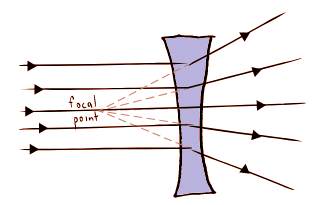
The Dual Focal Points
It is important to note that each lens has two focal points, equidistant from the lens but situated on opposite sides. The distance between the lens and the focal point is termed the focal length. Converging lenses always have positive focal lengths, while diverging lenses always possess negative focal lengths. However, it's crucial to recognize that these sign conventions are arbitrary and could have been defined differently by physicists.
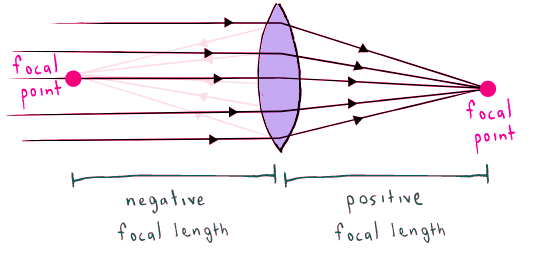
Thin Lens Rules and Sign Conventions
Having explored how to locate the focal point of a lens using a distant object, let's now examine the behavior of light rays from objects positioned closer to the lens.
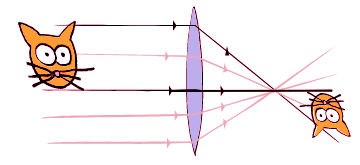
Converging Lens
Consider a cat standing on one side of a converging lens. Since converging lenses have two focal points, we assign a positive focal length to the point across the lens from the cat. Consequently, the focal point on the same side as the cat is assigned a negative value. In this scenario, the image of the cat forms across the lens from the actual cat and appears upside-down. Similarly, if the image is on the opposite side of the lens from the cat, the distance from the lens to the image will be positive.
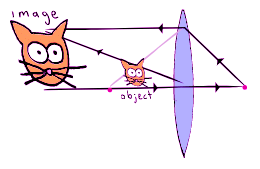
Diverging Lens
With a diverging lens, the positioning of the object does not influence the characteristics of the image. Regardless of whether the object is inside or outside the focal point, the resulting image will always be on the same side of the lens as the object. Moreover, the image will appear upright and smaller than the object. For diverging lenses, the image distance is negative.
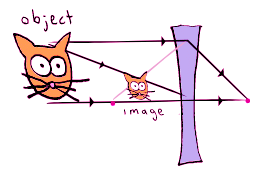
Understanding Magnification
Magnification refers to the change in size between the object and the image formed by the lens. A magnification greater than one indicates that the image is larger than the object, while a magnification smaller than one signifies that the image is smaller than the object. For instance, a magnification of one-half suggests that the image appears to be half the size of the object. The sign of the magnification provides information about the orientation of the image. A positive sign indicates an upright image, while a negative sign implies an upside-down image. Notably, the distance of an object from the focal point affects the extent of magnification.
Practical Applications and Observations
Let's explore a few everyday situations where the concepts of thin lenses and focal length become evident:
Vision Correction
Have you ever wondered how glasses aid individuals who struggle to focus on distant or close-up objects? Glasses use lenses to alter the path of light entering the eye, compensating for any irregularities in the eye's natural lens. By adjusting the focal point, glasses help achieve clearer vision at various distances.
The Mystery of Flipping Text
If you've ever used a magnifying glass to read fine print, you may have noticed that when the glass is moved too far from the page, the text appears flipped over and smaller. This phenomenon occurs because a magnifying glass is essentially a converging lens, and identifying the distance at which the image flips provides insight into its focal length.
Camera Lens Focus
Consider the fascinating process of how a camera lens focuses. Although the lens itself has a fixed focal length, the distance between the lens and the sensor or film strip adjusts as the camera is pointed at different subjects. This alteration ensures that the sensor sits at the appropriate image distance, resulting in sharp and focused photographs.
Conclusion
Understanding thin lens sign conventions provides valuable insights into the behavior of light as it interacts with lenses. By comprehending the properties of converging and diverging lenses, the concept of focal points, and the significance of magnification, we gain a deeper appreciation for the intricacies of vision correction, magnification tools, and even photography. The next time you put on a pair of glasses or examine an object through a lens, you'll have a newfound understanding of the fascinating optical principles at play.
|
158 videos|21 docs|21 tests
|














